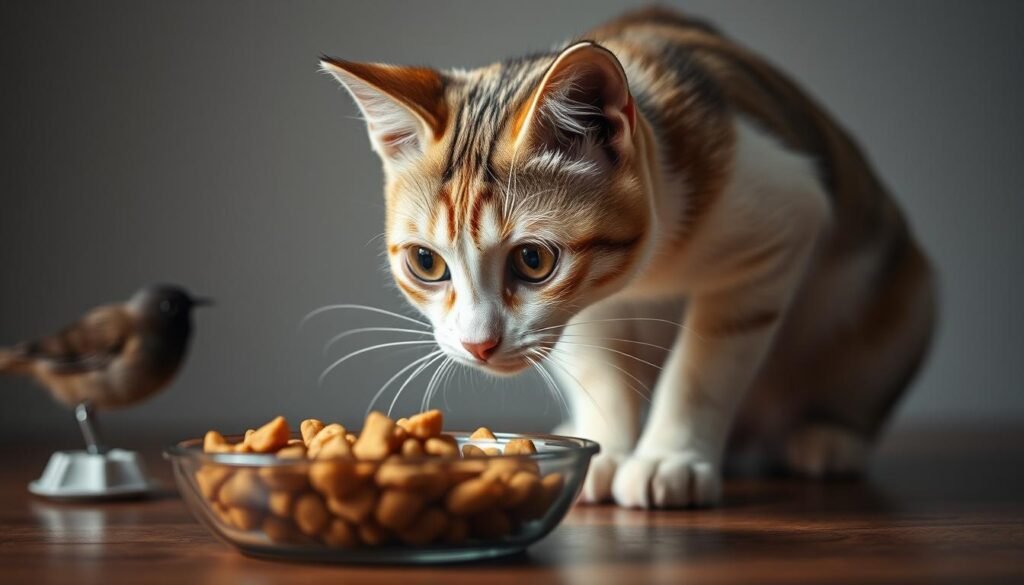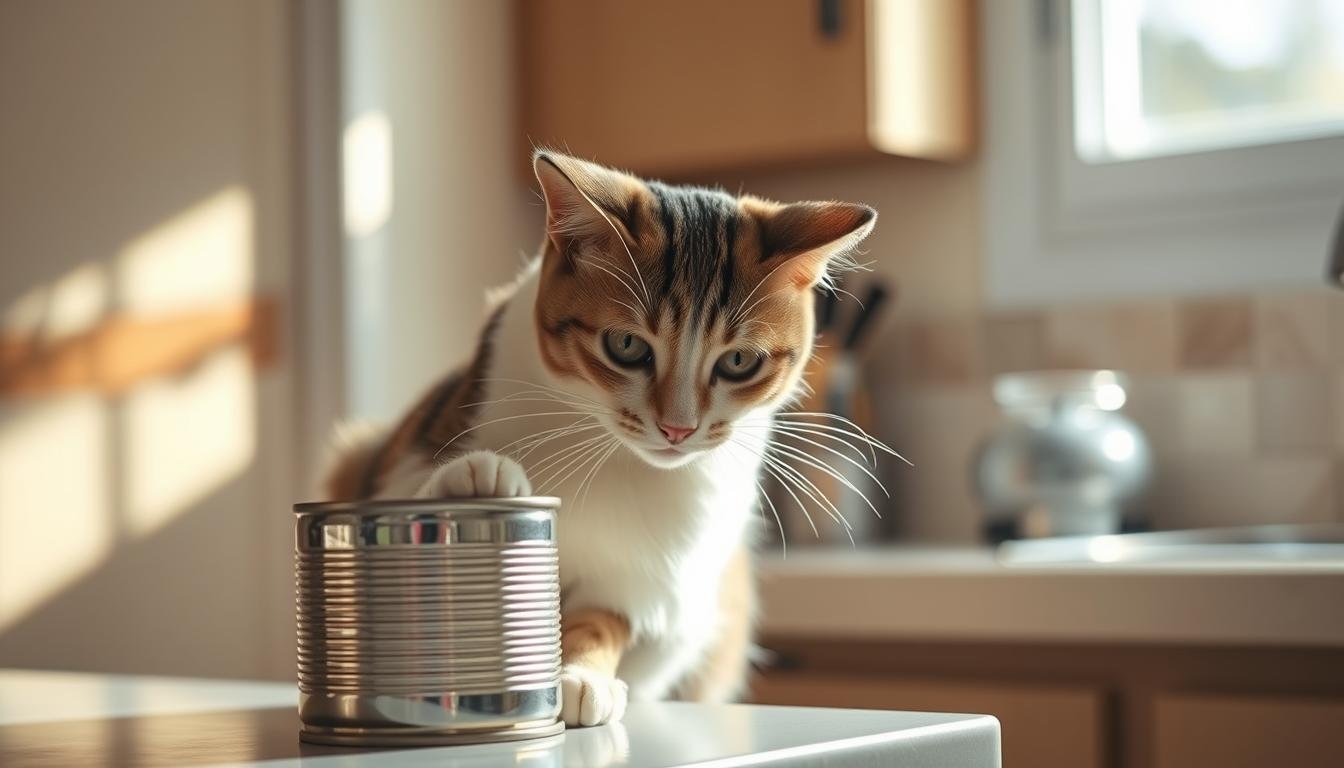Troubling Cat Behavior Changes After Introducing New Food
Table of Contents
As a cat owner, you know your feline friend likes routine. Any change, like new food, can stress or excite them. It’s important to understand these behavioral changes for your cat’s
You might see changes in your cat’s eating, energy, or mood. These changes often come from feline dietary adjustments. Knowing this helps you ease the transition to new food for your cat.
Knowing your cat’s usual behavior helps spot changes after diet changes.
Understanding Your Cat Behavior Changes
It’s important to know how your cat usually eats to spot any changes. Cats are picky eaters, influenced by their wild roots and likes.
Typical Feline Eating Patterns
Cats like to eat small meals often, not big ones at set times. This comes from their wild ancestors’ hunting ways.
How Cats Naturally Select Food
Cats choose food based on what they need to eat. In the wild, they hunt for food that gives them the right nutrients. This instinct stays with domestic cats, making them picky about what they eat.
The Role of Smell and Texture in Food Preferences
Smell and texture are key in what cats like to eat. Their sense of smell helps them pick fresh, tasty food. Texture also matters, with some cats preferring wet or dry food.
| Factor | Influence on Feline Eating Behavior |
|---|---|
| Smell | Highly influences food preference and detection of freshness |
| Texture | Affects palatability and preference for certain types of food |
| Taste | Plays a role in the overall acceptance of food |
Knowing these eating habits helps you notice any changes after new food. This ensures a smooth transition and keeps your cat healthy.
Cat Behavior After New Food Introduction
When you introduce new food to your cat’s diet, you may notice a range of reactions. Cats are creatures of habit. Changes in their diet can lead to various behavioral responses.
Initial Hesitation and Food Avoidance
Some cats may show initial hesitation or avoid the new food. This is common, as cats are naturally cautious with new smells, textures, or tastes. You might see your cat sniffing at the new food but not eating it, or they might walk away from the food bowl.
Changes in Appetite and Consumption Patterns
After introducing new food, you may see changes in your cat’s appetite or eating patterns. Some cats may eat more or less than usual. Others may be more finicky about their food. It’s important to watch these changes to make sure your cat gets enough nutrients.
Altered Activity Levels After Meals
The introduction of new food can also change your cat’s activity levels. Some cats may become more lethargic, while others may become more active or demanding. These changes can be due to the nutritional content of the new food or the stress of adjusting to a new diet.
By understanding these potential behavioral changes, you can better support your cat during the transition to new food. Monitoring their behavior and adjusting their diet accordingly can help minimize any adverse reactions.
Why Cats React Strongly to Dietary Changes
Feline dietary adjustments can be tough because of their sensitivity to food changes. Cats have a special biology and psychology that affects their eating habits. These factors influence how they react to new foods.
Biological Sensitivity to New Ingredients
Cats are naturally cautious about new foods. Their sensitive sense of smell and taste greatly influence their food choices. New ingredients can be seen as a threat, leading to a strong reaction.
The Psychological Aspect of Food Routines
Cats love their routines, and eating is a big part of their day. Changing their food can upset this routine, causing psychological distress. Cats prefer a steady environment, and diet changes can be unsettling.
Neophobia: Fear of New Foods in Cats
Neophobia, or fear of new foods, is common in cats. This fear helps them avoid harmful substances. When introducing new food, it’s key to do it slowly to avoid food refusal.
Knowing these factors helps manage your cat’s reaction to diet changes. By understanding their biological and psychological needs, you can ease the transition to new food. This makes the change less stressful for your cat.
Digestive Responses and Related Behavior Changes
Your cat’s digestive health is closely tied to their diet. Changes in food can cause noticeable behavior shifts. When introducing new food, their digestive system may take time to adjust, leading to various responses.
Gastrointestinal Adjustment Period
Introducing new food can start a gastrointestinal adjustment period in cats. Their digestive system adapts to the new ingredients. This can sometimes cause discomfort or changes in appetite.
Signs of Digestive Discomfort
Cats may show several signs of digestive discomfort after a diet change. These include changes in stool consistency and changes in how often they use the litter box.
Changes in Stool Consistency
A change in stool consistency is a common sign of how your cat is adjusting to new food. Stools may become softer or more firm, depending on the new diet’s ingredients.
Frequency of Litter Box Visits
The new diet can also affect how often your cat uses the litter box. Some cats may go more often, while others may go less often.

| Signs | Description | Possible Cause |
|---|---|---|
| Soft or Diarrheic Stool | Stool is loose or watery | New ingredients, potential sensitivity |
| Constipation | Difficulty in passing stools | Insufficient fiber, new diet |
| Increased Litter Box Visits | More frequent visits to the litter box | Digestive discomfort, new diet |
It’s important to watch for these changes to understand your cat’s adjustment to new food. If you see persistent or severe digestive issues, it’s best to talk to a vet. This ensures your cat’s health and comfort.
The Proper Way to Transition Your Cat’s Food
Switching your cat’s food too quickly can upset their stomach. A careful transition is key. It helps your cat adjust to the new food without stress.
The 7-10 Day Gradual Transition Method
Gradual introduction is the secret to a smooth food change. Start by mixing a small amount of new food with their old diet. Slowly increase the new food over 7-10 days. This gradual transition period lets your cat’s stomach get used to the new food.
For example, on days 1-2, mix 25% new food with 75% old food. By days 3-4, increase it to 50% new and 50% old. Keep going until you’re feeding 100% new food by days 7-10.
Monitoring Behavior During Transition
It’s important to watch your cat’s behavior during the change. Look for signs like vomiting or diarrhea. Also, notice if they eat less or move less.
Slowing Down for Sensitive Cats
If your cat seems uncomfortable or upset, slow down the transition. For sensitive cats, you might need to extend the transition period beyond 10 days.
When to Pause the Transition
If your cat keeps having stomach problems or eats less, pause the transition. It’s best to pause the transition and talk to your vet for advice.
When Food-Related Behavior Changes Are Concerning
Changes in your cat’s behavior after new food can worry you. It’s key to know when to get vet advice. Some changes are normal, but others mean you should see a vet.
Red Flags That Require Veterinary Attention
If your cat won’t eat, vomits, has diarrhea, or seems tired after new food, see a vet. These signs could mean they’re not okay with the new food or have a health problem.
- Persistent refusal to eat
- Vomiting or diarrhea
- Signs of abdominal pain or discomfort
- Lethargy or depression
Distinguishing Between Normal Adjustment and Problems
Cats might be slow to try new foods, but if they won’t eat for a long time or seem upset, it’s not normal. Watching your cat closely is important. If you’re not sure, talking to a vet can help.
Normal adjustment behaviors include being a bit hesitant or slowly getting used to new food over a few days. But if these signs don’t go away or get worse, you need vet advice.
Behavioral Signs of Food Allergies or Intolerances
Food allergies or intolerances can show up in different ways, like a lot of scratching, skin problems, or stomach issues. If you see these signs, it’s important to talk to a vet to figure out why and change your cat’s diet.
Knowing about these issues helps you take care of your cat’s health when you change their food.
Different Types of Cat Food and Their Behavioral Effects
The type of cat food can really affect how your cat acts. Whether it’s dry, wet, raw, or special prescription food, it can change their behavior and how they react to it.
Dry vs. Wet Food Behavior Differences
Cats can act differently depending on their food. Dry food might make them drink more water and use the litter box more often. But, wet food can mean they drink less water and might make a mess while eating.
Raw Diet Transition Behaviors
Switching to a raw diet can be exciting or scary for cats. Some might get really excited about food, while others might be picky. It’s important to watch how your cat reacts during this change.
Grain-Free and Novel Protein Diets
Grain-free and new protein diets can affect cats in various ways. They’re often for cats with food allergies or sensitivities. Cats might have better fur and fewer tummy problems, but they might not like the new food at first.
Prescription Diet Acceptance Challenges
Prescription diets are made for cats with specific health needs. But, cats might find them hard to get used to. Slowly introducing the new food with their current food can help them accept it better.
Knowing how different cat foods can affect behavior helps you choose the best diet for your cat. By picking the right food and introducing it slowly, you can reduce any bad behavior and keep your cat happy and healthy.
Addressing Specific Behavioral Issues During Food Changes
Cats may show different behaviors when their food changes. They might not want to eat the new food or start begging more. They could even get aggressive.
Food Refusal Strategies
If your cat won’t eat the new food, start by mixing it with their old food. Slowly add more of the new food over time. Warming the new food a bit can make it smell better and be more appealing.
Managing Increased Begging or Aggression
Some cats beg or get aggressive when their food changes. Keep their meal times the same every day. Don’t feed them from the table to avoid begging. For aggression, make mealtime as calm as possible.
Calming Techniques During Mealtime
Make the area where your cat eats quiet and free from distractions. Using pheromone diffusers can also help reduce stress during meals.
Creating Positive Associations with New Food
Make the new food positive by rewarding your cat with treats or praise. This way, they’ll learn to associate the new food with good things.

Long-Term Management of Your Cat’s Diet and Behavior
Managing your cat’s diet for the long term is crucial. It requires consistent feeding, understanding environmental factors, and ways to make food appealing.
Creating Consistent Feeding Routines
Having a regular feeding schedule makes your cat feel safe. It helps them develop a good relationship with food. Consistency reduces stress and makes mealtime predictable.
Environmental Factors That Affect Eating Behavior
The place where your cat eats is very important. Things like noise levels, location, and even the type of bowl used can affect their appetite.
Positive Reinforcement Techniques for Food Acceptance
Positive reinforcement helps your cat accept new foods. You can use rewards for eating new food and slowly introduce new diets.
- Start with small amounts of new food mixed with their current diet.
- Gradually increase the proportion of new food over time.
- Be patient, as some cats may take longer to adjust.
When to Consult Your Veterinarian About Food Transitions
When you introduce new food to your cat, knowing when to see a vet is important. Changing your cat’s diet can cause different behaviors and health changes.
Persistent Behavioral Changes
Some cats may not want to eat new food or eat more than usual. These signs could mean there’s a bigger problem that needs a vet’s help.
Weight Loss or Gain Concerns
It’s important to watch your cat’s weight when you change their food. If they lose or gain a lot of weight, it might mean the new food isn’t right. Veterinary guidance is key to fix this.
Specialized Dietary Needs Assessment
Cats with health problems or allergies might need special food. A vet can check what your cat needs and suggest the best food.
Nutritional Counseling Benefits
Vets can give great advice on what food is best for your cat. They help you understand what your cat needs and make good food choices.
| Signs | Possible Causes | Veterinary Action |
|---|---|---|
| Persistent refusal to eat new food | Food aversion, digestive issues | Adjust diet, check for underlying health issues |
| Significant weight loss or gain | Inadequate nutrition, health problems | Recommend suitable diet, monitor health |
| Signs of digestive discomfort | Food intolerance, allergies | Specialized dietary assessment, nutritional counseling |
Conclusion: Supporting Your Cat Through Dietary Changes
It’s important to know how your cat acts when you change their food. Cats have their own way of eating, based on smell and texture. When you bring in new food, watch for changes in how much they eat and how active they are.
Helping your cat adjust to new food takes time. Start by mixing the new food with their old food over 7-10 days. Keep an eye on how they’re doing, including their digestion and overall health. This way, you can catch any problems early and make the change easier for them.
By paying attention to your cat’s behavior after introducing new food, you can avoid issues. Changing their food, whether it’s a new brand or type, needs careful attention to their specific needs and likes.

